Starter motor, starting system: how it works, problems, testing
Updated: July 09, 2021
The starter motor is an electric motor that turns over or "cranks" the engine to beginning. Information technology consists of a powerful DC (Straight Electric current) electrical motor and the starter solenoid that is attached to the motor (encounter the flick).
In most cars, the starter motor is bolted to the engine or manual, check these photos: photograph 1, photograph 2. See how the starter motor works inside beneath.
The starter motor is powered by the car's main 12-volt battery. To turn over the engine, the starter motor requires loftier electric current, which means the battery has to have sufficient power. If the battery is discharged, the lights in a car might work, only it won't be enough power (current) to turn over the starter motor.
What are the symptoms of a bad starter motor: When starting a auto with a fully charged bombardment, at that place is a single click or nothing happens at all. The starter motor doesn't run, even though there is a 12-Volt power at the starter control terminal.
Another symptom is when the starter motor runs, but fails to turn over the engine. Often, this might cause a loud screeching dissonance when starting the automobile. Of course, this could also be acquired past damaged teeth on the ring gear of the flex plate or flywheel.
Starter solenoid
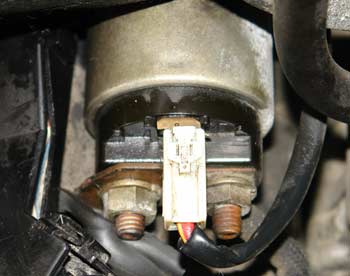 Starter solenoid.
Starter solenoid.
A typical starter solenoid has ane small connector for the starter control wire (the white connector in the photograph) and two large terminals: one for the positive bombardment cable and the other for the thick wire that powers the starter motor itself (meet the diagram below).
The starter solenoid works as a powerful electric relay. When activated, through the control terminal, the solenoid closes the hi-current electric excursion and sends the battery power to the starter motor. At the same fourth dimension, the starter solenoid pushes the starter gear forward to mesh with the ring gear of the engine flexplate or flywheel.
Battery cables
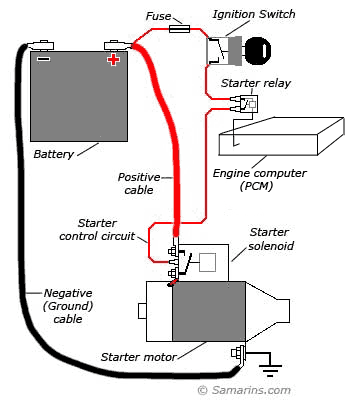 Starting system simplified diagram.
Starting system simplified diagram.
As we mentioned, the starter motor requires very high electrical electric current to plough over the engine. That's why information technology'southward continued to the bombardment with thick (large judge) cables (encounter the diagram). The negative (ground) cable connects the negative "-" battery terminal to the engine cylinder block, or transmission, close to the starter. The positive cable connects the positive "+" bombardment final to the starter solenoid. Ofttimes, a poor connection at i of the battery cables can cause the starter motor non to piece of work.
How the starting organization works:
When you plow the ignition primal to the First position, or press the Starting time push button, if the transmission is in Park or Neutral, the battery voltage goes through the starter command excursion and activates the starter solenoid. The starter solenoid powers the starter motor. At the same time, the starter solenoid pushes the starter gear forward to mesh it with the engine flywheel (flexplate in an automatic transmission). The flywheel is attached to the engine crankshaft. The starter motor spins, turning over the engine crankshaft assuasive the engine to get-go. In cars with a push start, the system disengages the starter as soon as the engine starts running.
Neutral safe switch
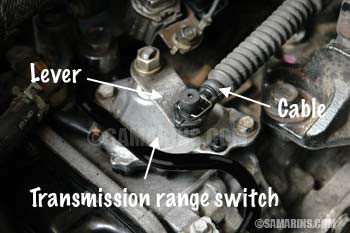 Automated manual range switch.
Automated manual range switch.
For prophylactic reasons, the starter motor can only be operated when the automatic transmission is in Park or Neutral position. In a auto with a transmission transmission, the enigne can only exist started when the clutch pedal is depressed. In vehicles with a manual manual, the clutch pedal switch completes the starter motor circuit when pressed. In cars with an automatic transmission, the transmission range switch allows the starter to operate simply when a transmission is in Park or Neutral.
The job of the transmission range switch is to tell the vehicle reckoner (PCM) which gear the transmission is in.
If your car has a gear indicator on the dash, you might be able to meet when a manual range indicator is not working. The nearly common problem is when y'all shift the transmission into "Park" and the letter "P" doesn't show on the nuance. This ways that the vehicle computer (PCM) doesn't know that the transmission is in "Park" and will non permit the starter to operate.
The symptom of this trouble is when the vehicle starts in Neutral, but doesn't starting time in "Park". Read more than: Why a car won't get-go in Park merely starts in Neutral?
Starting system problems
Starting system problems are common and not all of them are caused by a faulty starter motor. To discover the cause of the trouble, the starting arrangement must be properly tested. If when yous are trying to start the machine, you hear that the starter cranks as usual, just the automobile doesn't start, then the problem is most likely not with the starting system. Read more than The engine cranks but won't beginning. Here are a few mutual starting system problems:
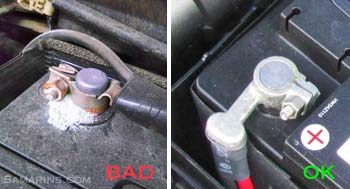 Corroded concoction terminal Good connexion
Corroded concoction terminal Good connexion
The battery is very mutual to fail. Sometimes one of the electrical components that was left on or has a defect causing parasitic current describe drains the battery. Sometimes, an erstwhile bombardment can only die one solar day, with no warning. In either case, if the battery is low on charge, it won't have enough power for the starter motor to plow over the engine.
If the battery is depression on charge, when attempting to starting time the engine you might hear a single click or repeated clicking, or the starter may turn over slowly and end.
Poor connection at the cable terminals can crusade the starter not to work or run very slow besides. Often the battery terminals or the ground cable connectedness go corroded causing starter problems (see the photo in a higher place).
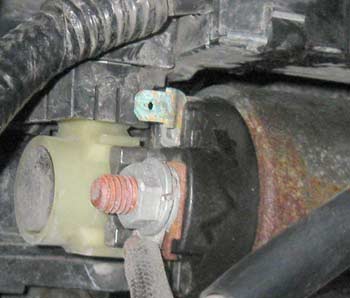 Corroded starter solenoid control terminal
Corroded starter solenoid control terminal
Sometimes the starter control terminal gets corroded (in the photo) or a starter control wire gets loose or disconnected from the terminal causing the starter non to work. For example, this corroded starter control terminal was the cause of a no-offset, no-creepo condition in the Mazda 3. Nosotros merely noticed this after disconnecting the control wire connector. Cleaning the terminal and replacing the connector solved the problem.
Another part that often fails is the starter motor itself. Sometimes the carbon brushes or some other parts inside the starter motor wear out and the starter motor stops working.
For instance, a failed starter motor was mutual in some Toyota Corolla and Matrix models. Even with a skillful bombardment, the starter would click, but would not turn over.
If the starter motor is faulty, it will have to be replaced, which may cost from $250 to $650. Rebuilding the starter motor is usually cheaper, but takes more time.
Sometimes the starter gear for some reason won't mesh properly with the engine flywheel. This may cause a very loud metallic grinding or screeching sound when attempting to showtime the car. In this case, the flywheel ring gear needs to exist checked for damaged teeth.
An ignition switch also fails often. The contact points inside the ignition switch habiliment out, and so when you plow the ignition switch to the "Commencement" position, no electric electric current is going through the starter control circuit to activate the starter solenoid. If jiggling the key in the ignition helps start the machine, it'southward possible that the ignition switch is defective.
A neutral safety switch can also fail or get out of aligning. For example, if a automobile starts in "Neutral" only doesn't start in "Park," the neutral safety switch should be checked first.
How the starting system is tested
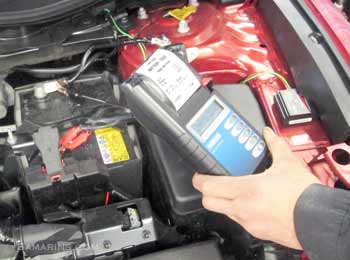 A technician checks the battery state of accuse with the battery tester
A technician checks the battery state of accuse with the battery tester
When the starter motor doesn't work, first the land of charge of the battery, bombardment terminals and battery cables must exist checked. One of the symptoms of a weak battery is when the dash lights go dim when the key is turned to the START position.
The next footstep typically involves testing the starter command excursion. Your mechanic may starting time by measuring the battery voltage at the starter solenoid control final with the key in the Get-go position. If there is no voltage, the problem is most likely in the starter control excursion (ignition switch, starter relay, neutral condom switch, control wire). If in that location is a battery voltage at the starter solenoid control terminal with the key in the Start position, the starter motor itself could be bad. The starter solenoid control terminal must besides exist checked for proper connectedness.
How does the starter motor work inside?
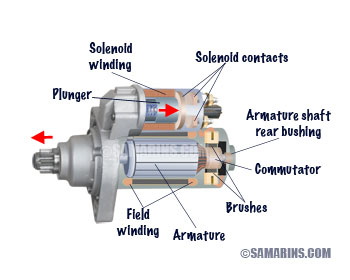 Starter motor inside
Starter motor inside
The starter motor typically has four field windings (field coils) fastened to the starter motor housing from the inside. The armature (the rotating part) is connected through the carbon brushes in serial with the field coils. On the forepart end of the armature, there is a pocket-size gear that is attached to the armature through an overrunning clutch.
How does the starter motor work? When the driver turns the key or presses the Start button, the solenoid winding is energized. The solenoid plunger moves in the direction of the pointer and closes the solenoid contacts. This connects the battery power to the starter motor (field coils and armature). At the same time, the plunger pushes the starter gear forward through the lever. The gear then engages with the ring gear of the flexplate and turns it over. The flexplate is attached to the engine crankshaft.
Most of the starter problems are caused by worn out or burned solenoid contacts, worn brushes and a commutator and worn armature bushings. The symptom of worn out solenoid contacts is when the solenoid clicks but the starter motor doesn't run. When the starter brushes are worn out, the starter motor doesn't make any noises. When front end and rear armature bushings wear out, the armature rubs against the field shoes causing the starter motor to run irksome and noisy. Many modern starter motors take small ball bearings instead of the bushings. If you want to rebuild the starter motor, the starter motor rebuild kits that include common wearable parts are sold online.
Source: https://www.samarins.com/glossary/starter.html
Posting Komentar